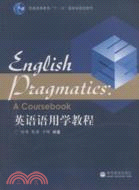相關商品
商品簡介
目次
商品簡介
介紹語用學基本理論以及最新研究方法和視角。 由概念解釋或現象描述,到理論介紹和實例分析,再到延伸閱讀推薦和練習思考,幫助學生全面深入地掌握語用學基本內容,提高學生語言感悟能力和語言交際能力。 例證鮮活,均為當今生活中的實例,具有很強的時代氣息。 深入淺出,語言簡明,易懂易學。
目次
1 Background and definitions
1.1 Background ofpragmatic
1.2 Definitions of pragmatics
1.3 Component vs. perspective
1.4 Uses ofpragmatics
1.5 Aims ofpragmatics
1.6 Summary and further reading
Questions for discussion
2 Deixis and reference,
2.1 Definition of deixis
2.2 Types of deixis
2.2.1 Person deixis
2.2.2 Spatial deixis
2.2.3 Temporal deixis
2.2.4 Discourse deixis
2.2.5 Social deixis
2.3 Definition of reference
2.4 Referential and attributive usages of referring expressions
2.5 The role of context in identifying referents
2.6 The role of co-text in identifying referents
2.7 The role of anaphora, cataphora and zero anaphora in
maintaining reference
2.8 Summary and further reading
Questions for discussion
3 Presupposition
3.1 Definition of presupposition
3.2 Distinguishin presupposition from entailment
3.3 Types of presupposition
3.3.1 Existential presupposition
3.3.2 Lexical presupposition
3.3.3 Sfiuctural presupposition !
3.3.4 Facdve presupp0sition
3.3.5 Non-factive presupposition
3.3.6 Counter-factual esipposidon
3.4 Problematic properties
3.4.1 Defeasibility
3.4.2 Projection problem
3.5 Summary and further reading
Questions for discussion
4 Conversational implicature (I)
4.1 Definition ofimplicature
4.2 The cooperative principle
4.3 The four conversational maxims
4.3.1 Observing the maxims
4.3.2 Non-observance of the mans
4.4 Types ofimplicature
4.4.1 Conventional implicature
4.4.2 Conversational implicature
4.5 Properties of conversational implicature
4.5.1 Cancelability
4.5.2 Non-detachability
4.5.3 Calculability
4.5.4 Non-conventionality
4.6 Summary and further reading
Questions for discussion
5 Conversational implicature (II)
5.1 The politeness principle
5.2 The six main maxims
5.2.1 The tact maxim
5.2.2 The generosity maxim
5.2.3 The approbation maxim
5.2.4 The modesty maxim
5.2.5 The agreement maxim
5.2.6 The sympathy maxim
5.3 The relationship between the politeness principle and
the cooperative principle
5.4 Problems with Leechs politeness principle
5.5 Summary and further reading
Questions for discussion
6 The relevance-theoretic framework
6.1 The origin of relevance theory
6.2 The principle of relevance
6.2.1 The notion of relevance
6.2.2 The cognitive and the communicative principles of relevance
6.3 The notion of context
6.3.1 Cognitive environment
6.3.2 Context selection
6.4 Relevance-guided comprehension
6.4.1 A comprehension heuristic
6.4.2 Implicature vs. explicature
6.5 Constraints on relevance
6.5.1 Conceptual and procedural encoding
6.5.2 Types of contextual effects
6.6 Summary and further reading
Questions for discussion
7 Speech act theory
7.1 Definition of speech act
7.2 Composition of a speech act
7.3 Recognition ofillocutionary force
7.3.1 Definition ofillocutionary force
7.3.2 Illocutionary force indicating devices
7.3.3 Felicity conditions
7.4 Classification of speech acts
7.4.1 Approaching the functions of speech acts
7.4.2 Approaching the performance of speech acts
7.5 Beyond speech act theory speech events
7.6 Summary and further reading
Questions for discussion
8 Conversation analysis
8.1 Introduction
8.2 Theoretical preliminaries
8.3 Turn-taking organization
8.3.1 Turn constructional unit
8.3.2 Turn-allocation component
8.3.3 Turn-taking rules
8.4 Adjacency pairs
8.4.1 Insertion sequence
8.4.2 Conditional relevance
8.5 Preference organization
8.5.1 Preferred vs. dispreferred second
8.5.2 Agreeing and disagreeing with assessments
8.5.3 Repair
8.6 Pre-sequence
8.6.1 Pre-announcements
8.6.2 Pre-requests
8.6.3 Summons-answer
8.7 Summary and further reading
Questions for discussion
9 Conclusions
9.1 Approaches to pragmatics
9.2 The multidiscipfinary nature of pragmatics
9.2.1 Pragmatics and branches of micro-linguistics
9.2.2 Pragmatics and interdisciplinary fields
9.3 The dynamic perspective of pragmatics
9.3.1 The dynamics of communication
9.3.2 The construction of meaning
9.4 The application ofpragmatics
9.5 Summary and further reading
Questions for discussion
References
1.1 Background ofpragmatic
1.2 Definitions of pragmatics
1.3 Component vs. perspective
1.4 Uses ofpragmatics
1.5 Aims ofpragmatics
1.6 Summary and further reading
Questions for discussion
2 Deixis and reference,
2.1 Definition of deixis
2.2 Types of deixis
2.2.1 Person deixis
2.2.2 Spatial deixis
2.2.3 Temporal deixis
2.2.4 Discourse deixis
2.2.5 Social deixis
2.3 Definition of reference
2.4 Referential and attributive usages of referring expressions
2.5 The role of context in identifying referents
2.6 The role of co-text in identifying referents
2.7 The role of anaphora, cataphora and zero anaphora in
maintaining reference
2.8 Summary and further reading
Questions for discussion
3 Presupposition
3.1 Definition of presupposition
3.2 Distinguishin presupposition from entailment
3.3 Types of presupposition
3.3.1 Existential presupposition
3.3.2 Lexical presupposition
3.3.3 Sfiuctural presupposition !
3.3.4 Facdve presupp0sition
3.3.5 Non-factive presupposition
3.3.6 Counter-factual esipposidon
3.4 Problematic properties
3.4.1 Defeasibility
3.4.2 Projection problem
3.5 Summary and further reading
Questions for discussion
4 Conversational implicature (I)
4.1 Definition ofimplicature
4.2 The cooperative principle
4.3 The four conversational maxims
4.3.1 Observing the maxims
4.3.2 Non-observance of the mans
4.4 Types ofimplicature
4.4.1 Conventional implicature
4.4.2 Conversational implicature
4.5 Properties of conversational implicature
4.5.1 Cancelability
4.5.2 Non-detachability
4.5.3 Calculability
4.5.4 Non-conventionality
4.6 Summary and further reading
Questions for discussion
5 Conversational implicature (II)
5.1 The politeness principle
5.2 The six main maxims
5.2.1 The tact maxim
5.2.2 The generosity maxim
5.2.3 The approbation maxim
5.2.4 The modesty maxim
5.2.5 The agreement maxim
5.2.6 The sympathy maxim
5.3 The relationship between the politeness principle and
the cooperative principle
5.4 Problems with Leechs politeness principle
5.5 Summary and further reading
Questions for discussion
6 The relevance-theoretic framework
6.1 The origin of relevance theory
6.2 The principle of relevance
6.2.1 The notion of relevance
6.2.2 The cognitive and the communicative principles of relevance
6.3 The notion of context
6.3.1 Cognitive environment
6.3.2 Context selection
6.4 Relevance-guided comprehension
6.4.1 A comprehension heuristic
6.4.2 Implicature vs. explicature
6.5 Constraints on relevance
6.5.1 Conceptual and procedural encoding
6.5.2 Types of contextual effects
6.6 Summary and further reading
Questions for discussion
7 Speech act theory
7.1 Definition of speech act
7.2 Composition of a speech act
7.3 Recognition ofillocutionary force
7.3.1 Definition ofillocutionary force
7.3.2 Illocutionary force indicating devices
7.3.3 Felicity conditions
7.4 Classification of speech acts
7.4.1 Approaching the functions of speech acts
7.4.2 Approaching the performance of speech acts
7.5 Beyond speech act theory speech events
7.6 Summary and further reading
Questions for discussion
8 Conversation analysis
8.1 Introduction
8.2 Theoretical preliminaries
8.3 Turn-taking organization
8.3.1 Turn constructional unit
8.3.2 Turn-allocation component
8.3.3 Turn-taking rules
8.4 Adjacency pairs
8.4.1 Insertion sequence
8.4.2 Conditional relevance
8.5 Preference organization
8.5.1 Preferred vs. dispreferred second
8.5.2 Agreeing and disagreeing with assessments
8.5.3 Repair
8.6 Pre-sequence
8.6.1 Pre-announcements
8.6.2 Pre-requests
8.6.3 Summons-answer
8.7 Summary and further reading
Questions for discussion
9 Conclusions
9.1 Approaches to pragmatics
9.2 The multidiscipfinary nature of pragmatics
9.2.1 Pragmatics and branches of micro-linguistics
9.2.2 Pragmatics and interdisciplinary fields
9.3 The dynamic perspective of pragmatics
9.3.1 The dynamics of communication
9.3.2 The construction of meaning
9.4 The application ofpragmatics
9.5 Summary and further reading
Questions for discussion
References
主題書展
更多
主題書展
更多書展本週66折
您曾經瀏覽過的商品
購物須知
大陸出版品因裝訂品質及貨運條件與台灣出版品落差甚大,除封面破損、內頁脫落等較嚴重的狀態,其餘商品將正常出貨。
特別提醒:部分書籍附贈之內容(如音頻mp3或影片dvd等)已無實體光碟提供,需以QR CODE 連結至當地網站註冊“並通過驗證程序”,方可下載使用。
無現貨庫存之簡體書,將向海外調貨:
海外有庫存之書籍,等候約45個工作天;
海外無庫存之書籍,平均作業時間約60個工作天,然不保證確定可調到貨,尚請見諒。
為了保護您的權益,「三民網路書店」提供會員七日商品鑑賞期(收到商品為起始日)。
若要辦理退貨,請在商品鑑賞期內寄回,且商品必須是全新狀態與完整包裝(商品、附件、發票、隨貨贈品等)否則恕不接受退貨。

























